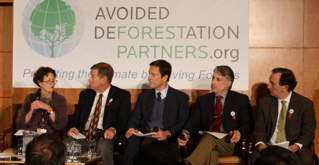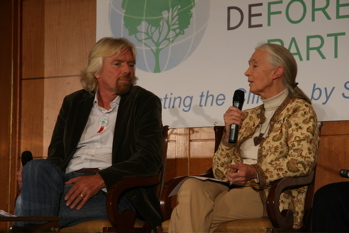Seeing REDD+: A bright spot in the forest
Dec 16, 2009 - by Staff
Dec 16, 2009 - by Staff
Bob Henson | 17 December 2009 • “The U.N. conference in Copenhagen appears to be imploding from within and exploding from without,” lamented Politico on Wednesday, 16 December. The external protests were real enough. Thousands of activists surrounded the Bella Center, some trying to enter the conference site. More than 200 were arrested.
 A Congo rainforest. (Photo by Lee Klinger.)
A Congo rainforest. (Photo by Lee Klinger.)
As for the internal dynamics, it’s hard to separate the unique stresses of Copenhagen from the usual course of events at climate negotiations. In 1997, the embryonic Kyoto Protocol almost sank before a last-minute rescue engineered in part by Al Gore, then the U.S. vice president. Still, there continue to be major points of contention among participants in Copenhagen. The baton gets passed to heads of state on Friday in what may be the largest gathering of presidents and prime ministers since World War II.
Amid the strife, one area of acknowledged progress is in ways to help preserve tropical forests and their vast stores of carbon in developing countries. The Kyoto Protocol encourages the creation of new forests and the reestablishment of destroyed ones (afforestation and reforestation), but it includes no provisions for preventing deforestation, largely because of difficulties in assessing and monitoring the state of forests.
In the 12 years since Kyoto, satellites and other tools have greatly enhanced our ability to monitor forest health. No matter what happens in the overall negotiations, the stars appear to be aligning for a major agreement by week’s end in the general sphere known as reducing emissions from deforestation and degradation (REDD).
REDD emerged from the 2007 UN climate conference in Bali. It’s since been broadened to an approach known as “REDD plus” or REDD+, which includes conservation, sustainable management, and enhancement of forests and their carbon stocks.
Getting REDDy for prime time: A flurry of action since Bali has led to more than 100 activities aimed at demonstrating REDD+ and establishing readiness for it, according to a preliminary survey compiled this year by the Center for International Forestry Research. The push at Copenhagen has been to raise enough money to kick REDD+ activities into overdrive. With deforestation responsible for 15–20% of global emissions—as much or more than all transportation sources—protecting existing forests could be one of the most straightforward and cost-effective ways to reduce humanity’s carbon footprint.
 Panelists at the REDD+ side event included Frances Beinecke (president, Natural Resources Defense Council), Dennis Welch (executive vice president, American Electric Power), Mark Tercek (president, The Nature Conservancy), David Yarnold (executive director, Environmental Defense Fund), and Peter Seligmann (chairman, Conservation International).
Panelists at the REDD+ side event included Frances Beinecke (president, Natural Resources Defense Council), Dennis Welch (executive vice president, American Electric Power), Mark Tercek (president, The Nature Conservancy), David Yarnold (executive director, Environmental Defense Fund), and Peter Seligmann (chairman, Conservation International).
REDD+ inspired one of the highest-profile side events of the week, sponsored on Wednesday by the crosscutting group Avoided Deforestation Partners. The speakers ranged from legendary researcher Jane Goodall and billionaire businessman Richard Branson to several prime ministers and a Who’s Who of leaders from U.S. environmental groups (see photo at left), all pushing for a strong REDD+ deal in Copenhagen.
At heart, avoiding deforestation is a refreshingly low-tech approach. “We all know how not to cut down a tree,” noted Jens Stoltenberg, prime minister of Norway. His country has already devoted more than $400 million toward efforts to prevent deforestation. Stoltenberg called it “the best investment we’ve ever made in avoiding global warming.”
U.S. secretary of agriculture Tom Vilsack drew a round of applause when he announced a U.S. commitment of $1 billion to support REDD+ groundwork. The pledge was joined by $2.5 billion more from Australia, France, Japan, Norway, and Britain.
Tempering that news were cautionary remarks from Guyana president Bharrat Jagdeo. More than 60% of his country is still covered with tropical rainforest, he said. But unless far more money is devoted to REDD+, he fears that economic imperatives will push landowners toward cutting down forest. “This is what it takes to outcompete alternative uses of the forest,” Jagdeo said of REDD+ investment.
 Eduardo Braga (right), governor of Brazil's Amazonas state, spoke out passionately in favor of REDD+: "Let's do it." Looking on are Julia Martion-Lefèvre, director general of the International Union for Conservation of Nature, and Carter Roberts, president of the World Wildlife Fund U.S.
Eduardo Braga (right), governor of Brazil's Amazonas state, spoke out passionately in favor of REDD+: "Let's do it." Looking on are Julia Martion-Lefèvre, director general of the International Union for Conservation of Nature, and Carter Roberts, president of the World Wildlife Fund U.S.
New eyes on the rainforest: World Bank president Robert Zoellick raised two of the perennial questions about REDD+: “How do you measure and how do you monitor?” In one hopeful sign, lidar-based technology from the Carnegie Institution is lending a boost to tropical forest assessment across Peru, as noted by a recent report in Nature. The technique provides “the coolest monitoring you have ever seen,” said Carter Roberts, president of the World Wildlife Fund U.S.
More good news: Deforestation in Brazilian Amazonia has dropped substantially in recent years, decreasing from some 28,000 square kilometers per year earlier in the decade to 13,000 sq km in 2007 and 7,000 sq km in 2008, according to Eduardo Braga, governor of Brazil’s Amazonas state. “This is effectiveness by any measure,” he said. However, experts fear that tree-cutting could shift westward to Peru with the construction of a transoceanic highway, which highlights the need for an inclusive approach to preventing deforestation.
“If any significant group of countries is left out, then deforestation will move to those jurisdictions, and we will have failed,” observed Jagdeo in his introduction to The Little REDD+ Book, a guide available online from the Global Canopy Program.
There was no shortage of high rhetoric at Wednesday's REDD+ meeting, with participants agreeing that a defining point was at hand in Copenhagen. As Roberts put it, “This may be one of the most important moments for forests in the history of the world.”
 While entrepreneuer Richard Branson expressed optimism that airlines will reduce emissions with or without a Copenhagen deal—"I'm absolutely convinced we can get the aviation industry to do it"—Jane Goodall appealed to both collective and individual action in order to reduce population- and livestock-induced pressures on tropical rainforests. "There is a lot that ordinary people in the developing world can do," said Goodall.
While entrepreneuer Richard Branson expressed optimism that airlines will reduce emissions with or without a Copenhagen deal—"I'm absolutely convinced we can get the aviation industry to do it"—Jane Goodall appealed to both collective and individual action in order to reduce population- and livestock-induced pressures on tropical rainforests. "There is a lot that ordinary people in the developing world can do," said Goodall.